Death Race 2000: how a sick, bloody exploitation movie drove Hollywood crazy
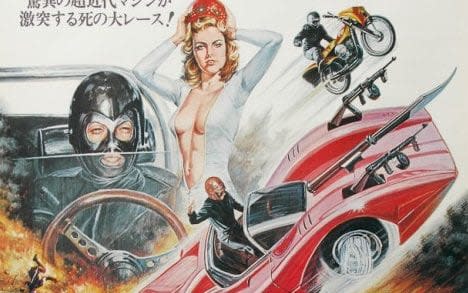
On a November afternoon in 1974 producer Roger Corman pulled up outside the Los Angeles Centre Studios complex in the city’s Westlake district and entered the building at speed. A confrontation was boiling over on the set of his new film and Corman had dashed across town to calm the situation.
Corman typically churned out movies the way sausage factories churn out strings of rubberised meat. Yet on this rare occasion he was eager for things to proceed as smoothly as possible. He had high hopes for the project – a dystopian road movie set in a crazed future American where the public is addicted to reality television and a bloviating showman nests in the White House.
Such was all lurid fantasy, of course. But the crisis at that moment confronting Corman – Hollywood's most notorious penny-pincher – was very real. One of the lesser known stars of Death Race 2000 was throwing a tantrum. Nobody, not even the director who had rescued the actor from obscurity, could talk sense to him.
At issue was a bared bum. Sex and violence were two of Corman’s favourite things when it came to putting posteriors on seats. Yet, though the actor in question was happy to wade in fake blood, he blanched at flashing his buns on screen.
“Roger came down to the set because Stallone wouldn’t do that scene,” Death Race co-star, Mary Woronov, would remember. “Roger said, “I am doing a t___ and ass movie. “They compromised and had a towel across his ass.”
As they stood there debating how much towel should cover a pre-Rocky Sylvester Stallone’s gluteus maximus, neither Corman nor any of his crew could have imagined they were making a future classic. But that is exactly what they were doing. When it zoomed onto screens four months later Death Race 2000 was revealed to be a savage satire of the Hollywood industrial complex.
It was also a rubber-burning romp that would inspire future generations of road movies. Death Race was gory, ridiculous and smart – one of the most iconic b-pictures of the decade.
That gonzo spirit of Death Race can be found in the new Sky show Curfew, a big budget, star-packed bash 'em up set in post-apocalyptic London. Curfew has its charms and if you enjoy Sean Bean looking a bit peeved – as if about to have his head chopped off – it’s the cyberpunk destruction derby for you.
But it is no Death Race 2000, which blended exploding blood bags and chainsaw-subtle social commentary as if they were always meant for each other.
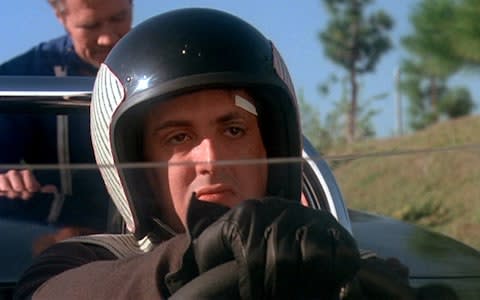
Corman’s eyes-on-stalks masterpiece also blazed a trail for Mad Max, the Running Man and the Hunger Games trilogy. Those films borrow unashamedly from Death Race in pitting teams of colourful weirdos against one another in future-shock spectator sports. And Death Race received the ultimate honour of a remake in 2008, starring Jason Statham, Tyerese Gibson, Ian McShane and Joan Allen (bizarrely Tom Cruise was on board as produce of an earlier proposed reboot).
Dystopian thrill rides to the death have since become their own cliche. Yet Death Race 2000 arguably went further than any of its peers – to a Kubruckian place where violence and satire were horrifically intertwined. Featuring mowed-down pensioners and a car decorated like a bull goring a matador it committed fully to its luridness. Not even the more iconic Mad Max could match it for excess (Mad Max creator George Miller would openly acknowledge his debt to Corman).
As with many pulp masterpieces the storyline is essentially non-existent. Racers bearing wrestler-style stage names speed from New York to New Los Angeles. En route, bonus points are scored for mowing down pedestrians. A teenager is worth 40, a toddler 70. Women carry an automatic 10 point bonus. The biggest prize of all, however, are the over 75s – worth 100 points.
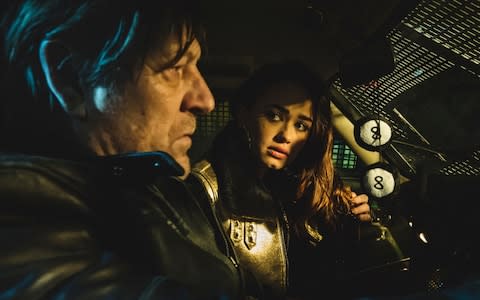
Along with the shock factor there was an impressive cast. David Carradine – future muse of Quentin Tarantino – portrayed anti-hero Frankenstein. Carradine, then 29, was one of the biggest stars on television on the back of his recently concluded martial arts show, Kung Fu. He was able to leverage an extraordinary deal from the notoriously tightfisted Corman by which he received 10 per cent of the box office gross.
Stallone played the boorish “Machine Gun” Joe. Woronov was “Wild West” driver Calamity Jane. Woronov was a counterculture celebrity by dint of her membership of Andy Warhol’s retinue at the Factory in New York. It is doubtful Warhol could ever have imagined for her a canvas half as barking as Death Race 2000. Her car was decorated to resemble a horned steer and at one point, she ran down a bull fighter, duly showered in fake blood.
Corman hadn’t exactly set out to make a tongue-waggling satire of the entertainment industry. Early in 1974 the doyen of low-budget filmmaking caught wind that United Artists was working on a dystopian sports thriller, to be called Rollerball.
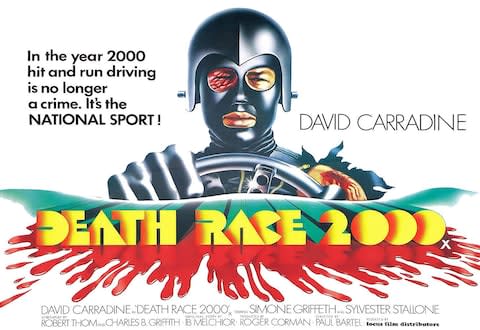
He had no idea what the movie was about. But to capitalise on the hype he decided to film his own wild riff on that idea, to be cobbled together for a paltry $300,000. As source material he picked an obscure – and entirely non-satirical – science fiction short story, The Racer, by Ib Melchior.
“Death Race was my idea. Racer had already been done as a film,” Corman later recalled, asked about the attention-grabbing title. “But then I thought this is a science fiction picture. How do we take the words and say it is a future film? This was about 1975… so let’s put 2000 on it.”
“It was a very serious, vicious short story. I thought [it] would be kind of interesting if I turned this into a satirical, ironic comedy – but still hold the underlying viciousness.”
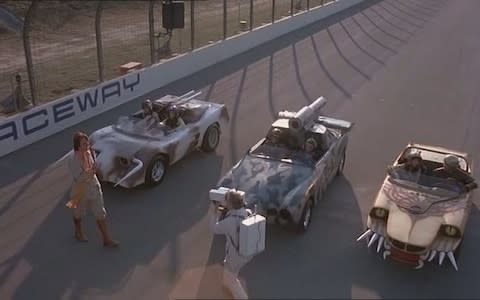
The viciousness was certainly preserved. “Euthanasia day at the geriatric hospital,” enthuses Frankenstein at one point as he and his driving partner Annie (Simone Griffeth) hurtled down the tarmac. As a sick joke, he swerves to avoid the invalids in the middle of the road and instead ploughs down screaming nurses. In another sequence a fan of Frankenstein sacrifices herself by standing in the middle of the laneway so that he can mow her down. He does so without blinking.
Blood bags were used freely. In one scene a stunt-man playing a bystander is pursued by a car into a lake. Down he goes and, pop, red dye spurts everywhere. Later, a character stretches leisurely on a roadside and – wham – a “Nazi” car covered in Third Reich symbols shoots past, squelching his head.
Death Race 2000 is that kind of film – silly, offensive, thrilled to tweak the audience’s nose. Yet it was also an action movie. Corman went to great effort – if not much expense – to ensure, in particular, that the cars looked the part.
Displaying the eye for a bargain for which he was both famed and disdained in Hollywood, he bought a job-lot of used Volkswagens Beetles. These he shipped to a car designer of his acquaintance.

“I was looking for a theme for each car: the gangster car, the western car, the Nazi car. I went to a custom car builder and told him I didn’t have much money…All he had to do was [modify] the body, which didn’t cost very much money because basically it was just a used Volkswagen.”
Car chases are notoriously complicated to film. Mad Max Fury Road nearly fell apart in the sands of Namibia. Tom Hardy is on record as saying he expected it to be a mess until he actually saw it. And Curfew went to the very top in hiring original Top Gear Stig Ben Collins to coordinate its driving scenes.
Determined to make every cent count, Corman cut out the middle man. “They mostly let the actors drive the cars,’ recalled screenwriter and second unit-director Charles B Griffith. “There were no back-up cars. No doubles.”
Corman had a reputation for giving a first break to young directors. Francis Ford Coppola and Brian De Palma had worked with him early in their careers. He would later take a chance on Ron Howard and James Cameron. For Death Race 2000 he hired Paul Bartel, who had worked on Corman exploitation features such as Private Parts.

The producer knew he and Bartel had diverging sensibilities and might clash. Bartel was a playful satirist – more artist than showman. “He had an excellent sense of humour,” recalled Griffith. “He saw the satire of it.” “Bartel was one of the best directors I worked with – he was very good with a kind of fey humour,” agreed Corman.
As anticipated by Corman, they didn’t always see eye to eye. “We had terrible script problems; David had to finish his Kung Fu series before starting and we had bad weather,” recalled Bartel, who passed away in 2000.
“We all worked under terrible pressure. Roger and I had an essential disagreement over comedy. He took out a lot of the comedy scenes. He may have been right and was probably more objective."
It was Bartel’s idea to cast Stallone, who had impressed as a street thug in 1974’s The Lords of Flatbush. “As soon as he read, I said this man is the best heavy I’ve ever seen,” Corman recalled to a making of documentary that accompanied the DVD re-release of Death Race in 2010. “I said at that time, ‘I don’t see him as a leading man. He’s just a good heavy’.”
Death Race 2000 received execrable reviews. Roger Ebert awarded it zero stars and was appalled by its mere existence. “The killings are depicted in the most graphic way possible. Giant swords on the fronts of the cars skewer victims. Others are run over several times,” said the dean of American film criticism.
“It becomes what it seems to have mocked – a spectacle glorifying the car is an instrument of violence,” added a despairing New York Times.
And yet the violence did not prompt much of an outcry and Death Race 2000 soon found its audience, earning $4 million at the box office. Over the decades, moreover, its reputation would grow – to the point where it is today regarded as far more than a gory b-movie. It was the entertainment satire the world hadn’t known it needed – a provocative commentary on how the blood, sweat and suffering is packaged and sold to the masses.
“It took years for people to see that,” said Griffith “It had to become an old picture and respected as a result before people saw that clearly. It’s a strange… it’s the cheap b-pictures that hold up and the a-pictures that fade away."


